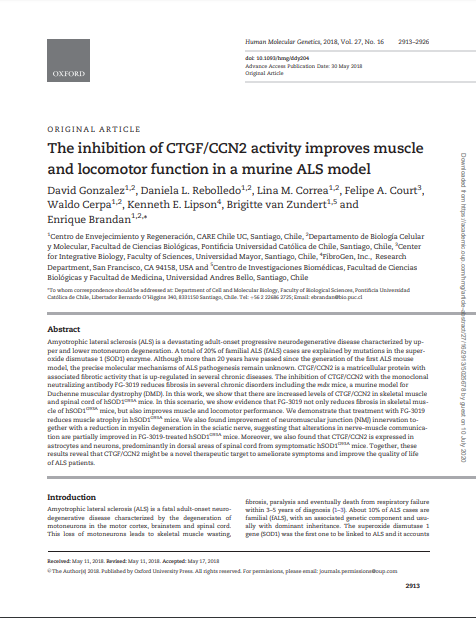The inhibition of CTGF/CCN2 activity improves muscle and locomotor function in a murine ALS model

Fecha
2018Autor
Court, Felipe A. [Univ Mayor, Ctr Integrat Biol, Fac Sci, Santiago, Chile]
González, David
Rebolledo, Daniela L.
Correa, Lina M.
Cerpa, Waldo
Lipson, Kenneth E.
van Zundert, Brigitte
Brandan, Enrique
Ubicación geográfica
Notas
HERRAMIENTAS
Acceda a títulos restringidos
¿Cómo descargar?Resumen
Amyotrophic lateral sclerosis (ALS) is a devastating adult-onset progressive neurodegenerative disease characterized by upper and lower motoneuron degeneration. A total of 20% of familial ALS (fALS) cases are explained by mutations in the superoxide dismutase 1 (SOD1) enzyme. Although more than 20 years have passed since the generation of the first ALS mouse model, the precise molecular mechanisms of ALS pathogenesis remain unknown. CTGF/CCN2 is a matricellular protein with associated fibrotic activity that is up-regulated in several chronic diseases. The inhibition of CTGF/CCN2 with the monoclonal neutralizing antibody FG-3019 reduces fibrosis in several chronic disorders including the mdx mice, a murine model for Duchenne muscular dystrophy (DMD). In this work, we show that there are increased levels of CTGF/CCN2 in skeletal muscle and spinal cord of hSOD193A mice. In this scenario, we show evidence that FG-3019 not only reduces fibrosis in skeletal muscle of hSOD1G93A mice, but also improves muscle and locomotor performance. We demonstrate that treatment with FG-3019 reduces muscle atrophy in hSOD1G93A mice. We also found improvement of neuromuscular junction (NM)) innervation together with a reduction in myelin degeneration in the sciatic nerve, suggesting that alterations in nerve-muscle communication are partially improved in FG-3019-treated hSOD1G93A mice. Moreover, we also found that CTGF/CCN2 is expressed in astrocytes and neurons, predominantly in dorsal areas of spinal cord from symptomatic hSOD1G93A mice. Together, these results reveal that CTGF/CCN2 might be a novel therapeutic target to ameliorate symptoms and improve the quality of life of ALS patients.
Coleccion/es a la/s que pertenece:
Si usted es autor(a) de este documento y NO desea que su publicación tenga acceso público en este repositorio, por favor complete el formulario aquí.